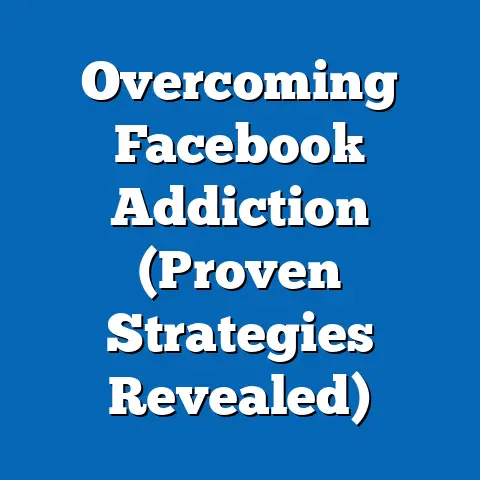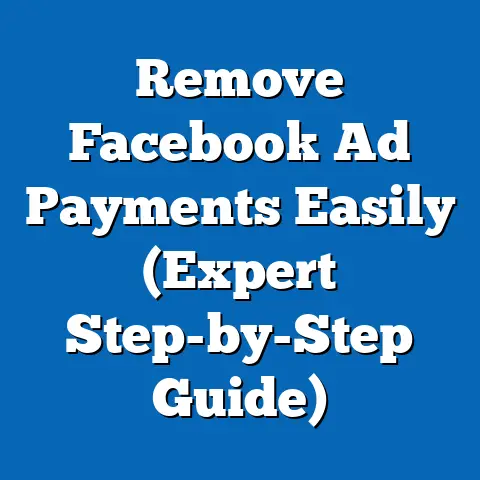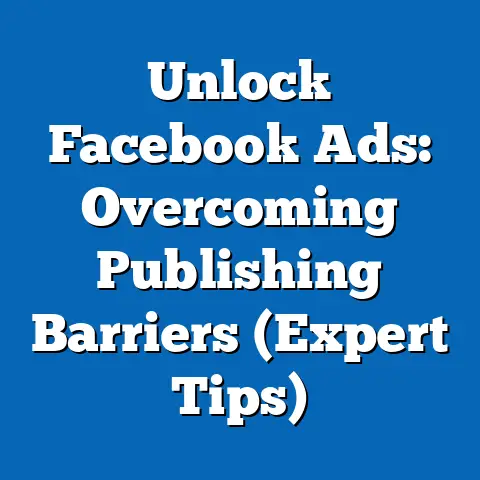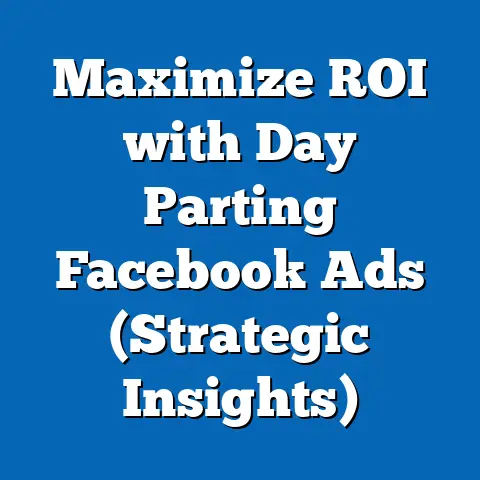Unlocking ThruPlay Success (Mastering Facebook Engagement)
In today’s whirlwind digital world, where everyone’s vying for attention, cracking the code to ThruPlay on Facebook isn’t just a cool trick—it’s a survival skill for brands that want to stand out. Think of it as your VIP pass to grabbing and holding eyeballs on the world’s biggest social stage.
I remember when I first started diving into Facebook ads, I was overwhelmed by all the metrics. Impressions, reach, clicks – it was a confusing alphabet soup. But then I discovered ThruPlay, and it was like a lightbulb went off. It wasn’t just about getting people to see my ad; it was about getting them to watch it. And that’s a game-changer.
This guide is your roadmap to not just understanding, but mastering, ThruPlay. We’ll break down everything from crafting videos that people can’t help but watch to pinpointing your perfect audience and squeezing every last drop of value out of your ad budget. Get ready to transform your Facebook video ads from background noise into engaging experiences that drive real results.
Understanding ThruPlay: Beyond the Basics
So, what exactly is ThruPlay? Simply put, it’s Facebook’s way of tracking how many times your video ad is watched all the way through – or for at least 15 seconds. Why is this important? Because it tells you that people are genuinely interested in what you have to say. They’re not just scrolling past; they’re investing their time.
Think of it like this: impressions tell you how many people saw your ad, but ThruPlay tells you how many people cared about it. It’s a much more meaningful metric because it reflects actual engagement.
Now, you might be wondering, “How does ThruPlay differ from other video metrics?” Great question! Here’s a quick breakdown:
- Impressions: The number of times your ad was displayed.
- Reach: The number of unique people who saw your ad.
- Views: The number of times your video was watched for at least 3 seconds.
- ThruPlay: The number of times your video was watched to completion (or at least 15 seconds).
See the difference? ThruPlay goes beyond mere visibility and measures genuine interest.
The ThruPlay Algorithm: What Facebook Wants
Facebook’s algorithm is a mysterious beast, but here’s what we know about how it relates to ThruPlay:
- Quality Content: Facebook prioritizes content that it believes users will find engaging. If your video has a high ThruPlay rate, it signals to Facebook that your content is valuable, and they’re more likely to show it to more people.
- Relevance: Facebook wants to show users content that is relevant to their interests. If your video is targeted to the right audience, you’ll see a higher ThruPlay rate.
- User Experience: Facebook wants to create a positive user experience. If your video is annoying, disruptive, or low-quality, it’s less likely to be shown.
ThruPlay in Action: Real-World Impact
I’ve seen firsthand how focusing on ThruPlay can transform a Facebook ad campaign. I once worked with a local bakery that was struggling to get traction with their video ads. They were getting plenty of impressions, but no one was watching the videos. We decided to revamp their content strategy, focusing on creating short, engaging videos that showcased their delicious treats and highlighted their unique story. The result? Their ThruPlay rate skyrocketed, and they saw a significant increase in foot traffic to their bakery.
Key Takeaway: ThruPlay is a crucial metric for measuring video ad engagement on Facebook. It goes beyond mere visibility and reflects genuine interest, making it a powerful indicator of campaign success.
Next Step: Start thinking about how you can create more engaging video content that captures attention and keeps viewers watching.
In today’s world of endless scrolling, you have mere seconds to grab someone’s attention. That means your video needs to be captivating from the very first frame.The Power of Storytelling
Humans are wired for stories. We connect with them on an emotional level, and they’re far more memorable than dry facts and figures. When creating your video, think about how you can tell a story that resonates with your audience.
- Problem/Solution: Highlight a problem your audience faces and then present your product or service as the solution.
- Behind-the-Scenes: Give viewers a glimpse into your company culture, your production process, or the people behind your brand.
- Customer Testimonials: Let your happy customers tell their stories about how your product or service has helped them.
Visual Appeal: Make It Stunning
Your video needs to be visually appealing to capture attention and hold it. Here are a few tips:
- High-Quality Footage: Invest in good lighting, a stable camera, and professional editing.
- Eye-Catching Graphics: Use motion graphics, animations, and text overlays to add visual interest.
- Brand Consistency: Make sure your video aligns with your brand’s visual identity, including colors, fonts, and overall style.
Emotional Triggers: Tap into Feelings
Emotions are powerful drivers of behavior. When creating your video, think about how you can tap into your audience’s emotions.
- Humor: Make people laugh and they’ll be more likely to remember your brand.
- Inspiration: Share stories of success, overcoming obstacles, or making a difference.
- Nostalgia: Tap into fond memories of the past to create a sense of connection.
Attention-Grabbing Hooks: Nail the First Few Seconds
The first few seconds of your video are critical. If you don’t grab attention quickly, people will scroll right past. Here are a few hook ideas:
- Ask a Question: Pose a question that piques your audience’s curiosity.
- Make a Bold Statement: Start with a surprising or controversial statement.
- Show a Compelling Visual: Open with a stunning image or video clip.
Real-World Examples: Brands That Get It Right
- Dollar Shave Club: Their hilarious and irreverent videos went viral, showcasing their product in a memorable way.
- GoPro: Their user-generated videos of extreme sports and outdoor adventures showcase the capabilities of their cameras.
- Dove: Their “Real Beauty” campaign challenged traditional beauty standards and resonated with women around the world.
Key Takeaway: Compelling video content is essential for maximizing ThruPlay on Facebook. Focus on storytelling, visual appeal, emotional triggers, and attention-grabbing hooks to create videos that people can’t help but watch.
Next Step: Brainstorm video ideas that align with your brand and target audience, focusing on creating content that is both engaging and informative.
Targeting Your Audience Effectively: Precision is Key
You could have the most amazing video in the world, but if you’re showing it to the wrong people, it’s going to fall flat. That’s why audience targeting is so crucial for ThruPlay success. It’s all about getting your video in front of the people who are most likely to be interested in it.
Facebook’s Targeting Options: A Treasure Trove of Data
Facebook offers a wealth of targeting options, allowing you to pinpoint your ideal audience with incredible precision. Here are some of the key options:
- Demographics: Target users based on age, gender, education, relationship status, job title, and more.
- Interests: Target users based on their interests, hobbies, and passions.
- Behaviors: Target users based on their online behavior, purchase history, and device usage.
- Location: Target users based on their geographic location, from countries to cities to zip codes.
Custom Audiences: Your Secret Weapon
Custom Audiences allow you to target your existing customers and website visitors. This is a powerful way to re-engage people who are already familiar with your brand. Here are a few types of Custom Audiences you can create:
- Website Traffic: Target people who have visited your website.
- Customer List: Upload a list of your customer email addresses or phone numbers.
- App Activity: Target people who have used your mobile app.
- Engagement: Target people who have interacted with your Facebook page or ads.
Lookalike Audiences: Expand Your Reach
Lookalike Audiences allow you to find new people who are similar to your existing customers. This is a great way to expand your reach and find potential customers who are likely to be interested in your product or service.
Analyzing Audience Insights: Data-Driven Decisions
Facebook provides detailed audience insights that can help you refine your targeting strategies. Pay attention to the following metrics:
- Demographics: See the age, gender, and location of your audience.
- Interests: Discover the interests and hobbies of your audience.
- Page Likes: See the other Facebook pages your audience likes.
- Purchase Behavior: Understand the purchase behavior of your audience.
Real-World Example: Targeting the Right Audience
I worked with a fitness studio that was struggling to attract new clients through Facebook ads. They were targeting a broad audience of people interested in fitness, but their ThruPlay rate was low. We decided to narrow their targeting to focus on people who were interested in specific types of fitness, such as yoga, Pilates, and HIIT. We also created a Lookalike Audience based on their existing customer list. The result? Their ThruPlay rate doubled, and they saw a significant increase in new client sign-ups.
Key Takeaway: Effective audience targeting is essential for maximizing ThruPlay on Facebook. Use Facebook’s targeting options, Custom Audiences, Lookalike Audiences, and audience insights to get your video in front of the right people.
Next Step: Analyze your existing customer data and website traffic to identify your ideal audience segments. Then, create targeted Facebook ad campaigns that speak directly to their needs and interests.
Optimizing Ad Placements and Budgets: Where and How Much?
You’ve created a killer video and targeted the perfect audience. Now it’s time to decide where to show your ad and how much to spend. Ad placements and budget allocation can have a significant impact on your ThruPlay rate and overall campaign performance.
Ad Placements: Choose Wisely
Facebook offers a variety of ad placements, each with its own strengths and weaknesses. Here are some of the most common options:
- Facebook Feed: This is the main news feed that users see when they log in to Facebook. It’s a great place to reach a broad audience, but it can also be competitive.
- Facebook Stories: These are short, vertical videos that disappear after 24 hours. They’re a great way to reach a younger audience and create a sense of urgency.
- Facebook In-Stream Videos: These are ads that play before, during, or after other videos on Facebook. They’re a great way to reach people who are already engaged with video content.
- Facebook Marketplace: This is a platform where people can buy and sell items. It’s a great place to reach people who are actively looking to make a purchase.
Selecting the Right Placements: Consider Your Objectives
The best ad placement for your video will depend on your campaign objectives and target audience. Here are a few guidelines:
- Brand Awareness: Facebook Feed and Stories are great for reaching a broad audience and increasing brand visibility.
- Lead Generation: Facebook Feed and Marketplace are great for driving traffic to your website or landing page.
- Conversions: Facebook Feed and In-Stream Videos are great for driving sales or other conversions.
Budget Allocation: Finding the Sweet Spot
Determining the right budget for your Facebook video ads can be tricky. You want to spend enough to reach your target audience and achieve your campaign objectives, but you don’t want to waste money on ineffective ads. Here are a few tips:
- Start Small: Begin with a small budget and gradually increase it as you see positive results.
- Set a Daily Budget: This will help you control your spending and avoid overspending.
- Use Facebook’s Budget Optimization Tools: Facebook offers tools that can automatically optimize your budget to get the best results.
Bidding Strategies: Maximize Your ROI
Facebook offers a variety of bidding strategies that can help you maximize your ROI. Here are a few of the most common options:
- Lowest Cost: Facebook will try to get you the lowest possible cost per result.
- Cost Cap: You set a maximum cost you’re willing to pay per result.
- Target Cost: You set a target cost you want to pay per result.
- Value-Based Bidding: Facebook will try to find you the most valuable customers.
Real-World Example: Placement and Budget Optimization
I worked with an e-commerce company that was selling handmade jewelry. They were running Facebook video ads in the Facebook Feed, but their ThruPlay rate was low and their cost per conversion was high. We decided to test different ad placements, including Facebook Stories and Facebook Marketplace. We also adjusted their bidding strategy to use Value-Based Bidding. The result? Their ThruPlay rate increased significantly, their cost per conversion decreased, and they saw a substantial increase in sales.
Key Takeaway: Optimizing ad placements and budgets is crucial for maximizing ThruPlay success on Facebook. Choose the right placements based on your campaign objectives and target audience, and use Facebook’s budget optimization tools and bidding strategies to get the best results.
Next Step: Experiment with different ad placements and budget allocations to find what works best for your business. Use Facebook’s reporting tools to track your results and make adjustments as needed.
Measuring and Analyzing Success: Data is Your Guide
You’ve launched your Facebook video ad campaign, but the work doesn’t stop there. It’s essential to measure your results, analyze your data, and make adjustments to improve your performance over time.
Key Metrics to Track: Beyond ThruPlay
While ThruPlay is a crucial metric, it’s not the only one you should be tracking. Here are a few other important KPIs:
- Reach: The number of unique people who saw your ad.
- Impressions: The number of times your ad was displayed.
- Engagement Rate: The percentage of people who interacted with your ad (likes, comments, shares).
- Click-Through Rate (CTR): The percentage of people who clicked on your ad.
- Cost Per Result: The cost you paid for each desired result (e.g., ThruPlay, click, conversion).
- Return on Ad Spend (ROAS): The revenue you generated for every dollar you spent on ads.
Tools and Resources: Facebook Analytics and Beyond
Facebook provides a wealth of tools and resources for measuring and analyzing your ad performance. Here are a few of the most useful:
- Facebook Ads Manager: This is your central hub for managing your Facebook ad campaigns. It provides detailed reporting on all your key metrics.
- Facebook Analytics: This tool allows you to track user behavior on your website and app, providing valuable insights into your customer journey.
- Google Analytics: This is a powerful web analytics tool that can provide even more detailed information about your website traffic.
Analyzing Your Data: Look for Patterns and Trends
When analyzing your data, look for patterns and trends that can help you understand what’s working and what’s not. Here are a few questions to ask yourself:
- Which videos are performing best? What do they have in common?
- Which audiences are most engaged? What are their demographics, interests, and behaviors?
- Which ad placements are driving the best results?
- Are there any areas where you can reduce costs or improve efficiency?
Continuous Improvement: A Never-Ending Process
Optimizing your Facebook video ad campaigns is a continuous process. You should be constantly testing new ideas, analyzing your results, and making adjustments to improve your performance over time.
Real-World Example: Data-Driven Optimization
I worked with a subscription box company that was running Facebook video ads to attract new subscribers. They were tracking all their key metrics, but they weren’t sure how to use the data to improve their performance. We decided to conduct a series of A/B tests, experimenting with different video creatives, targeting options, and ad placements. We carefully tracked the results of each test and used the data to make informed decisions about how to optimize their campaigns. The result? They saw a significant increase in new subscriber sign-ups and a substantial improvement in their ROAS.
Key Takeaway: Measuring and analyzing your results is crucial for optimizing your Facebook video ad campaigns. Track your key metrics, use Facebook’s reporting tools, and look for patterns and trends that can help you improve your performance over time.
Next Step: Set up tracking for your key metrics, analyze your data, and identify areas where you can improve your performance. Don’t be afraid to experiment and try new things.
Conclusion: Mastering ThruPlay for Facebook Domination
We’ve covered a lot of ground in this guide, from understanding the basics of ThruPlay to crafting compelling video content, targeting your audience effectively, optimizing ad placements and budgets, and measuring and analyzing your results. The key takeaway is that mastering ThruPlay is essential for enhancing Facebook engagement and driving better results for your brand.
Remember, Facebook advertising is not a “set it and forget it” strategy. It requires continuous monitoring, analysis, and optimization. By staying informed about the latest trends and best practices, and by consistently testing and refining your approach, you can unlock the full potential of Facebook video ads and achieve your business goals.
I’ve seen firsthand how powerful Facebook video advertising can be when done right. It’s not just about creating pretty videos; it’s about understanding your audience, crafting compelling stories, and using data to make informed decisions.
So, take what you’ve learned in this guide and put it into action. Start experimenting, start testing, and start optimizing. The world of Facebook advertising is constantly evolving, but with the right knowledge and the right approach, you can stay ahead of the curve and achieve ThruPlay success.
Call to Action:
What’s your biggest challenge with Facebook video advertising? Share your thoughts and experiences in the comments below. Let’s learn from each other and help each other achieve ThruPlay success! And if you found this guide helpful, please share it with your friends and colleagues who are looking to improve their Facebook video ad performance.






